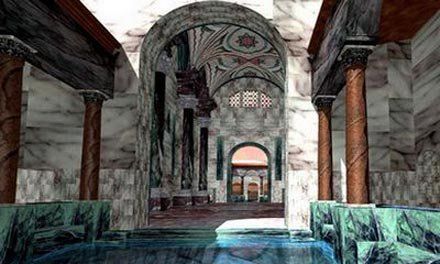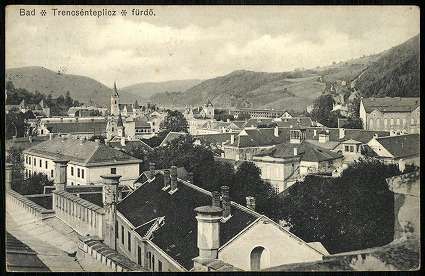Bathing culture before the age of dualism
The utilization of thermal and medicinal baths in the area of Hungary goes back to a history of 2,000 years. The ruins of buildings of former baths, ancient mosaics prove that the building of ’thermae’ was one of the significant characteristics of Roman urbanization in the province of Pannonia. The Roman baths served multiple purposes: one of these was hygienic, but, in addition, they represented favourite meeting places for the Romans as well. (Soós P. é.n.).
In the area of today’s Budapest alone the ruins of 19 Roman baths have so far been excavated. Ruins of private and public baths from the age of the Roman Empire can be seen in Nemesvámos-Balácapuszta, Balatongyörök, Örvényes and Balatonfüred. For further details see:
http://terebess.hu/keletkultinfo/soospeter.html

Figure 5. A computer-generated reconstruction of an ancient Roman bath. Source: mult-kor.hu (6)
The first settlements founded by our conquering ancestors were located in the vicinity of the hot water springs of Buda. As it is attested by contemporary documents, there were popular baths in Hungary as early as the age of Árpád, as well as of kings Sigismund and Mathias. (Pécsvárad, Esztergom, Buda, Balf, Eger). The Turkish baths of the age of the Ottoman Conquest were parts of building complexes including mosques, hospitals, schools and residential areas. The baths in the Ottoman Empire played a unique role in social life since they were the centres of ’beauty care’ and schools, too. (4) In the 16th century several Turkish baths were built in regions which had been occupied by the Ottoman army. Examples include Pécs, Szeged, Esztergom, Szolnok and Eger, but only the baths in Eger and some in Budapest are still in use. It is also to be noted that many of these baths got destroyed, and only some of them were rebuilt after the expulsion of the Turks. (e.g. Váradszentmárton, Herkulesfürdő) (Beluszky P. 2006).
Medical tourism in the ’modern’ sense of the word goes back to the 16-17th centuries in Hungary, when people began to frequent these medicinal baths. The first documents describing Hungary’s medicinal baths also go back to the same period. From these desriptions it can be learnt that Stubnyafürdő, Pöstyén, Bajmóc, or Trencsénteplic were favourtite meeting places for Hungary’s higher ranking nobiliaries and their escorts. (Beluszky P. 2006).
Hungarian bathing culture gained new impetus at the turn of the 18th and 19th centuries. Resorts built in idyllic surroundings also became meeting places for Hungary’s artists and politicians. (5). It was in Balatonfüred that a wooden bathhouse was built as early as 1743 in the vicinity of the settlement’s thermal springs. (People did not bathe in Lake Balaton at that time!) By the end of the 18th century medical service was added to the establishment and soon a whole bathing complex was born, complete with inns, promenades, medical halls, restaurants, ballrooms and parks. Balatonfüred became the best known health resort in Hungary, frequented by the dignitaries of the Pest-Buda region and Transdanubia in the Reform age. (Beluszky P. 2006).
After the Austro-Hungarian Compromise of 1867 a period of the strengthening of the middle class and a process of urbanization followed. Due to lifestyle changes in this period, which also meant the appearance of leisure time in the modern sense of the word, a new impetus was given to the development of bathing culture. By the second half of the 19th century it was real masses that visited these places, consisting of intellectuals, tradesmen, and government officials. (Kósa L. 1999).
In the period of the Austro-Hungarian Monarchy several resorts became extremely fashionable, some of which are deservedly well known today as well. (e.g.. Herkulesfürdő, Búziásfürdő, Harkány, Félixfürdő). This is also the period when the new forms of leisure time activities also came into existence, i.e. baths became parts of mass tourism. Lakeside, riverside resorts and baths emerged and became popular areas for recreation including the shores of Lake Balaton, the Római-beach in Buda, Palicsfürdő and Ruszanda-bath. It is interesting to note that it was as early as 1913 that Földvár and Lelle, and in 1914 Siófok, all located on the shores of Lake Balaton, were raised to the rank of health resorts.
It was also in this period that balneology began to emerge as an academic discipline. It aims to examine the effects of hot water therapies and physiotherapies. Balneotherapy was used successfully to treat an increasing number of diseases including locomotor, upper respiratory, metabolic, circulatory and neurotic problems. Medical experts usually prescribed 20-40 day therapies. (5). The foundation of the National Balneological Association in 1891 was also an event to emphasize the increasingly significant role of balneology in medicine.

Figure 6. Trencsénteplic 1908. Source: http://postcards.hungaricana.hu/ (7)
In Hungary the exploration of underground waters by drilling began in the second half of the 19th century. It was engineer Vilmos Zsigmondy (1821-1888) who pioneered the exploration of the hot water springs of several famous resorts including Félixfürdő and Széchenyi-fürdő. Int he period of the Austro-Hungarian Monarchy more than 1500 wells were drilled int he area of historical Hungary. (Lorberer Á. 2010). At the beginning of the 20th century 139 resorts qualified as medicianl baths. On the other hand contemporary guide books offered a list of 300+ places in Hungary where balneological services were available. Considering the annual number of guests (more than 16,000 guests per year), as well as the number and quality of its establishments, undoubtedly it was Pöstyén of Upper Hungary that was the best known place in 1911. Pöstyén was followed by Trencsénteplic, Herkulesfürdő, Félixfürdő, Hévíz, Harkány and. Balatonfüred (Beluszky 2006).